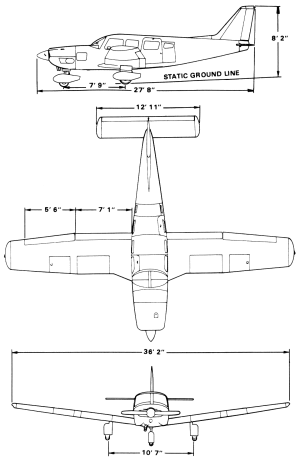Preliminary Report Shows Group Flying Together Encountered Deteriorating Weather On Their Route Of Flight
While the probable cause has not been established, the language of the NTSB's preliminary report concerning an accident which occurred July 18th near Fairbanks, AK sounds a familiar theme. The flight was a VFR cross-country trip, and the weather went to IFR as the flight progressed. It went down in a remote, rugged area of Alaska, resulting in the fatal injury of the pilot and a passenger in the Piper Saratoga. The examination of the airplane has not been completed, so no conclusions can be drawn. But another such story should make all of us take note.

NTSB Identification: ANC12FA066
14 CFR Part 91: General Aviation
Accident occurred Wednesday, July 18, 2012 in Fairbanks, AK
Aircraft: PIPER PA-32R-301, registration: N432LT
Injuries: 2 Fatal.
This is preliminary information, subject to change, and may contain errors. Any errors in this report will be corrected when the final report has been completed.
On July 18, 2012, about 1646 Alaska daylight time, a Piper PA-32-301 airplane, N432LT, sustained substantial damage during an uncontrolled descent and a collision with terrain about 43 miles north of Fairbanks, Alaska. The non-instrument rated private pilot and one passenger were fatally injured. The airplane was registered to LNP Saratoga Inc., Palo Alto, California, and operated by West Valley Flying Club, Palo Alto. The airplane was being operated as a 14 CFR Part 91 visual flight rules (VFR) cross-country personal flight when the accident occurred. At the time of the accident, instrument meteorological conditions were reported in the area of the accident. Visual meteorological conditions prevailed at the airplane's point of departure. The accident flight originated at the Fort Yukon Airport, Fort Yukon, Alaska, about 1600, en route to Fairbanks, the flight's final destination for the day.
According to the leader of the group the accident pilot was flying with, the accident airplane was the third of three airplanes that were touring northern Canada and Alaska. On the day of the accident, the group was scheduled to fly from Inuvik, Northwest Territories, Canada, to Fairbanks. The first airplane in the group flew to Fairbanks uneventfully. The other two airplanes encountered deteriorating weather conditions while en route to Fairbanks, which required an unscheduled stop in Fort Yukon to refuel. After departing Fort Yukon, the two airplanes again encountered marginal weather conditions. The pilot of one of the two airplanes requested, and received an instrument flight rules (IFR) clearance to Fairbanks. The accident airplane continued VFR, and the accident pilot reported to the pilot of the other airplane that he had found “a good VFR track.”

About 1641, the pilot contacted the Anchorage Air Route Traffic Control Center (ARTCC) specialist on duty, requesting an IFR clearance direct to Fairbanks. The approach controller instructed the pilot to climb to 7,000 feet, and issued a clearance direct to Fairbanks. At 1646, the ARTCC lost radio and radar contact with the accident airplane. No further communications were received from the accident airplane, and the airplane did not arrive at Fairbanks. It was officially reported overdue at 1719.
After being notified of an overdue airplane, search and rescue personnel from the Civil Air Patrol (CAP) began a search for the missing airplane near its last known location, close to an area known as the White Mountains. About 1948, the crew of the CAP airplane located the airplane's wreckage in an area of mountainous, tundra-covered terrain. Rescue personnel aboard an Air National Guard HH-60G helicopter reached the site later that night. A Pararescue Jumper (PJ) was lowered to the accident site, and confirmed that the airplane's occupants were deceased.
Continuous poor weather conditions prevented the NTSB IIC from reaching the site until July 20, along with an additional NTSB air safety investigator, and an FAA operations inspector from the Fairbanks Flight Standards District Office (FSDO). The wreckage was located on a brush and tundra-covered hillside. Portions of the fragmented airplane wreckage were scattered along a debris path oriented along a magnetic heading of 330 degrees, and measured about one-quarter mile in length.
A postaccident examination of the airplane is pending.
 ANN's Daily Aero-Linx (04.16.24)
ANN's Daily Aero-Linx (04.16.24) Aero-News: Quote of the Day (04.16.24)
Aero-News: Quote of the Day (04.16.24) Airborne 04.10.24: SnF24!, A50 Heritage Reveal, HeliCycle!, Montaer MC-01
Airborne 04.10.24: SnF24!, A50 Heritage Reveal, HeliCycle!, Montaer MC-01 Airborne 04.12.24: SnF24!, G100UL Is Here, Holy Micro, Plane Tags
Airborne 04.12.24: SnF24!, G100UL Is Here, Holy Micro, Plane Tags Airborne-Flight Training 04.17.24: Feds Need Controllers, Spirit Delay, Redbird
Airborne-Flight Training 04.17.24: Feds Need Controllers, Spirit Delay, Redbird




